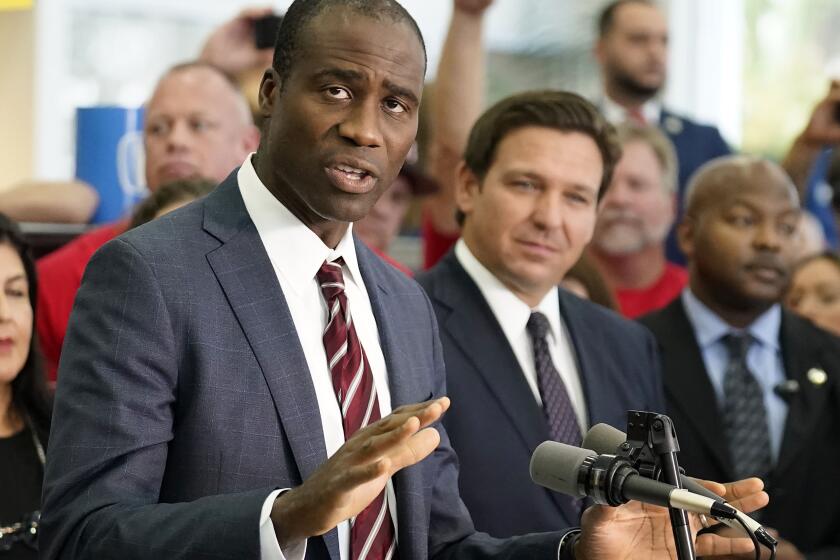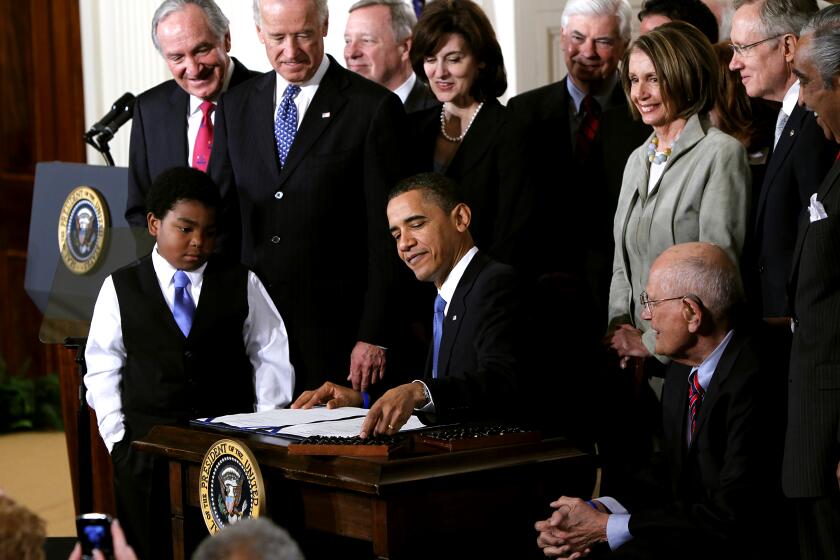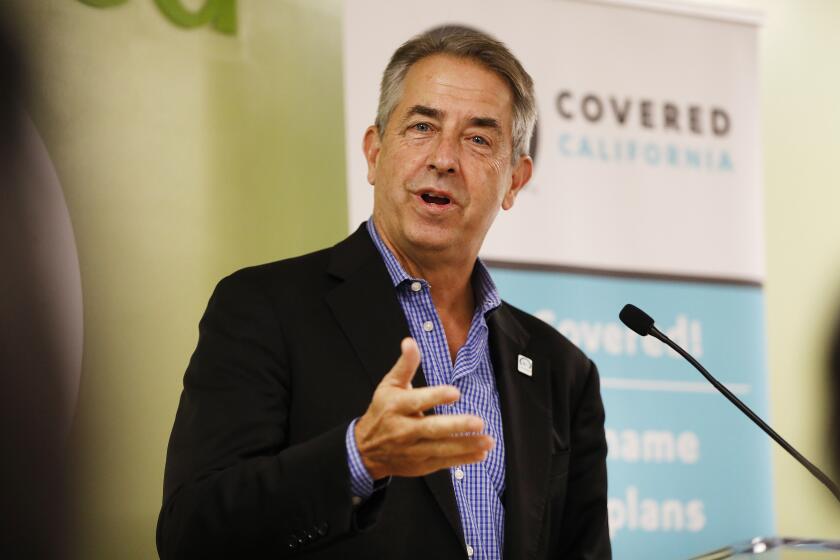Column: We know what Trump’s ‘concepts of a plan’ on healthcare would be. They would be deadly

- Share via
Donald Trump’s claim at his debate with Kamala Harris that he has “concepts of a plan” to reform healthcare in America has generated raised eyebrows and ridicule, as though he were merely fooling voters into thinking that he actually had been thinking about the issue despite having paid it zero attention.
It fell to Trump’s running mate, JD Vance, to put meat on those bare bones. What he offered is indigestible.
It’s also familiar. It’s the revival of “risk pools,” in which people with certain preexisting medical conditions are segregated into their own insurance markets, leaving healthy applicants to enjoy lower premiums based on the lesser likelihood that they would cost insurers money. The claim is that the sicker cohort can be protected separately. As we shall see, that’s wrong.
We want to make sure everybody is covered. But the best way to do that is to... not have a one-size-fits-all approach that... actually makes it harder for people to make the right choices for their families.
— JD Vance lies about Obamacare
Here’s how Vance put it during an interview Sept. 15 with Kristen Welker of NBC’s “Meet the Press”:
“A young American doesn’t have the same healthcare needs as a 65-year-old American. A 65-year-old American in good health has much different healthcare needs than a 65-year-old American with a chronic condition. And we want to make sure everybody is covered.
“But the best way to do that is to actually promote some more choice in our healthcare system and not have a one-size-fits-all approach that puts a lot of people into the same insurance pools, into the same risk pools, that actually makes it harder for people to make the right choices for their families,” he said.
Get the latest from Michael Hiltzik
Commentary on economics and more from a Pulitzer Prize winner.
You may occasionally receive promotional content from the Los Angeles Times.
Vance has repeated this incoherent claim in subsequent appearances. But the Affordable Care Act didn’t make it harder for people to “make the right choices” on healthcare, as he asserted; it opened health insurance to millions of families that had previously been excluded — as of this year, 45 million people are enrolled in Obamacare exchange plans or expanded Medicaid. America’s uninsured rate fell from 16% in 2010, before the ACA, to 7.7% at the end of 2023.
Nor is the ACA a “one-size-fits-all” program — it offers a range of alternatives for families and individuals to choose from, at different prices and different coverage modes. But it does mandate that some indispensable coverage is guaranteed for all.
At a theoretical level, Vance is right: If you put sick people into their own risk pool, then healthy people outside that pool can be charged less, so everybody wins. But he’s blowing smoke. We know this because the exact same idea was pushed by House Republicans under then-Speaker Paul Ryan (R-Wisc.) in 2016. At that time, I labeled the idea a “scam.” It still is.
Donald Trump, Ron DeSantis and Nikki Haley all want to repeal Obamacare. Their plan to replace it is not having any plan at all.
Vance is trying to assure the public that those with preexisting medical conditions will continue to be covered. He knows that a recrudescence of public concerns over coverage of preexisting conditions would be electoral poison. He may also be hoping that people have a rose-colored recollection of what it was like for those Americans in the dark ages before enactment of the Affordable Care Act in 2010.
The denial of insurance to people with preexisting conditions, or the imposition of premium surcharges to discourage them from applying, was eliminated so decisively by the ACA that many Americans have experienced “amnesia” about it, as Larry Levitt of KFF has termed the condition. Levitt fears that this amnesia has become an obstacle to warning voters what’s in store for them in a Trump administration.
Here’s a reminder. The pre-ACA business model in the individual insurance market was to reject applicants based on their medical history, or exclude coverage for their conditions, or jack up premiums for them to the point that coverage was unaffordable.
Insurers were ruthless about paring their customer base down to the youngest, healthiest applicants — those with minimal expected healthcare costs unless they were hit by a meteor.
The guidelines issued by Blue Shield of California ran to 25 pages. The “declinable conditions” — those for which applicants could be rejected without further medical review — included broken bones, kidney stones, depression, arthritis and psoriasis. Those with 21 varieties of cancer in their medical histories could be rejected automatically or offered coverage only at a higher premium.
So it’s unsurprising that Vance would try to couch his prescription in terms suggesting that it would safeguard coverage for preexisting conditions. That brings us to the history of risk pools.
Before the ACA, 35 states, including California, had established risk pools in one form or another. What we know about them is that they were massive failures.
Twelve red states still haven’t taken advantage of Obamacare’s economic benefits.
Ryan put his thumb on the discussion scale about risk pools in a couple of ways. He flagrantly underestimated the number of people who would be affected: He estimated the prevalence of Americans with preexisting conditions at 8% of adults under 65.
By contrast, the Department of Health and Human Services had estimated in 2011 that 50 million to 129 million Americans under 65, or as much as half the adult, nonelderly population, had some kind of preexisting condition. Up to 20% of them were uninsured. The ratio rose sharply with age, so that as many as 86% of those ages 55 to 64 were at risk of being denied insurance because of their medical condition.
Ryan also depicted risk pools as a novel free-market alternative to the ACA. It wasn’t; it was a hoary old chestnut that had already proved its inadequacy.
California’s pool, the Major Risk Medical Insurance Program, or “MR. MIP,” exemplified this problem. In 1990, when the program began with a $30-million budget funded by tobacco taxes, that was enough to enroll only 10,000 of the estimated 300,000 Californians who qualified. In 2009, enrollment was cut back to 7,100. Premiums were set as much as 37% higher than market rates for individual policies. The plans came with annual caps of $75,000 in benefits, not enough to cover treatments for some major diseases.
One state’s risk pool is typically cited as a success. It was Maine’s Guaranteed Access Reinsurance Assn., or MGARA. This pool was billed as “invisible” — enrollees didn’t know they were in it. Instead, all insurance customers had to fill out a questionnaire that insurers and the state used to determine who belonged in MGARA. As far as they knew, they were lumped in with everyone else.
MGARA was funded by taking 90% of the premiums paid to commercial insurers by enrollees in the pool, and charging all policyholders a $4 monthly surcharge. It was in place only for 18 months, or until implementation of the ACA made it irrelevant.
Importantly, during MGARA’s existence in 2012 and 2013, insurers were permitted to offer trimmed-down health plans — they weren’t required to offer maternity care coverage, for example, a huge cost center. That plainly discriminated against many women of child-bearing age and their families. The ACA mandates maternity and newborn coverage.
MGARA’s advocates assert that the secret of its success was that it was well-funded. Yet a 2017 analysis of the program for the Maine Legislature reported that the program had collected $41.2 million in premiums and assessments during its lifetime, but had paid out $66 million in claims. In other words, the program was in the red from the start; had it not been supplanted by Obamacare, it surely would have experienced rising deficits requiring a revision.
After 10 years in the ACA hot seat, Covered California boss Peter Lee looks back and ahead.
A federal version of risk pools as Vance outlined it would face the same challenge — how to pay for them. Vance neglected to mention that issue, but the cost of a national risk pool covering the people with medical conditions could be as high as $650 billion a year. That begins to approach the cost of our national defense establishment.
The Vance-Trump program, in reality, is deregulatory at its core. Vance told NBC’s Welker: Trump “of course does have a plan for how to fix American healthcare, but a lot of it goes down to deregulating the insurance market so that people can choose a plan that actually makes sense for them.”
Welker responded to this with the spectacularly ignorant statement, “So what I hear you’re saying is Obamacare stays in place.” What Vance said, of course, was exactly the opposite. He was talking about dismantling Obamacare’s protections for customers in the individual market root and branch. That, in fact, was Trump’s record as president.
He allowed short-term health plans to be renewed indefinitely, which meant allowing those bare-bones plans to siphon younger, healthier customers out of the overall health insurance pool. Insurance would be cheaper for them, because the policies would cover less; but much more expensive for everyone else, including those with a health condition that otherwise would be uncovered.
Trump also supported the Obamacare repeal and replacement plan passed by the Republican-controlled House in 2017. The bill, according to the Congressional Budget Office, would have taken away health insurance from 23 million Americans by 2026. Trump also advocated replacing the ACA’s premium subsidies and Medicaid expansion with a block grant to states. This plan, as Levitt observed, would have “reduced federal spending on the ACA and Medicaid by over $1 trillion over a decade.” But it would have left millions of Americans out in the cold.
The implications of the loss of coverage for Americans would be dire. Studies have consistently shown elevated mortality for uninsured adults compared with the population covered by commercial insurance — a death rate as much as 40% higher among uninsured adults than among the insured, according to a key 2009 paper.
That’s the world Trump and Vance want to return us to. Is America really ready to return to the dark ages?
More to Read
Get the latest from Michael Hiltzik
Commentary on economics and more from a Pulitzer Prize winner.
You may occasionally receive promotional content from the Los Angeles Times.














